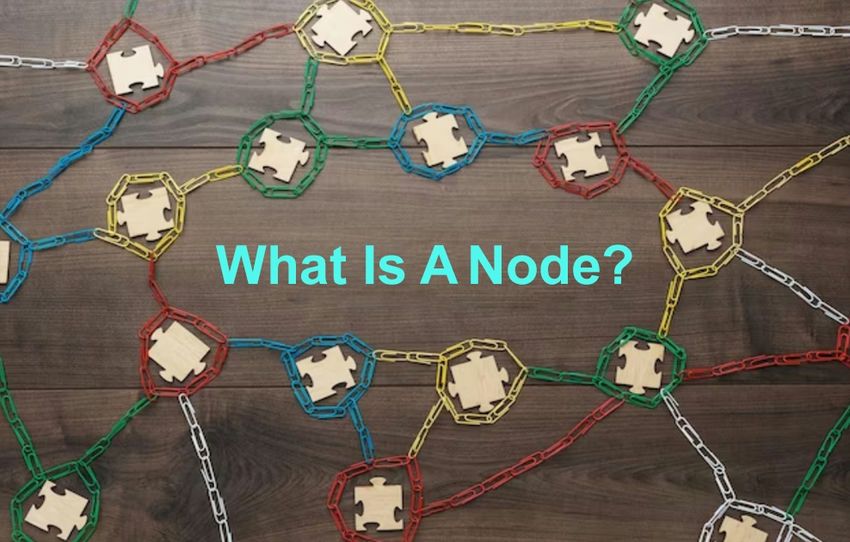A peer-to-peer network built specifically to follow a set of consensus rules is Bitcoin. With the help of these regulations, the transaction validation process is controlled, making the Bitcoin network resistant to transactional fraud without the need for a centralized design. The network is supported by inputs from some nodes; each independently verifies new transactions and broadcasts its findings to other nodes for additional examination or verification. This article will examine the functions of a Bitcoin node, the benefits of running one, and the steps involved.
What Is A Node?

A node can be compared to a real-world electronic gadget connected to a communication network. It permits information creation, receipt, and transmission via the communication channel. However, the specific definition of a node depends on the kind of network it is in.
What Is A Bitcoin Node?

A computer or device that runs the Bitcoin software and keeps a copy of the whole blockchain is called a Bitcoin node. The decentralized nature of the Bitcoin network depends heavily on nodes. They safeguard the consistency and security of the blockchain, validate transactions, and communicate information to other nodes. Lightweight nodes (SPV nodes) keep block headers and pertinent transaction information, while full nodes store a complete copy of the Bitcoin blockchain. By enabling users to independently verify transactions and participate in the consensus mechanism, running a full node improves the network’s decentralization and security.
What Is A Bitcoin Lightning Node?
The Lightning Network, a second-layer scaling solution for the Bitcoin blockchain, depends heavily on a Bitcoin Lightning Node. Through the routing and processing of off-chain transactions, it is a software solution that enables users to participate in the Lightning Network. Payment channels are established between users to allow quick and inexpensive transactions without the need to record every transaction on the primary blockchain. They are created and managed by lightning nodes. These nodes are essential to the network’s infrastructure because they enable instantaneous Bitcoin sending and receiving, promote microtransactions, and increase Bitcoin’s scalability for common use cases.
Difference Between Bitcoin Node Vs. Bitcoin Miner
| Factors | Bitcoin Node | Bitcoin Miner |
|---|---|---|
| Purpose | Validation and Propagation: Nodes validate and propagate transactions and blocks across the network. They maintain a copy of the blockchain and help in relaying information. | Block Creation: Miners are responsible for creating new blocks by solving complex mathematical puzzles (Proof of Work) to add transactions to the blockchain. They compete to find the next block and are rewarded with newly minted bitcoins and transaction fees. |
| Role | Network Backbone: Nodes act as the backbone of the Bitcoin network, ensuring decentralization, security, and redundancy. | Block Producer: Miners are the entities that generate and add new blocks to the blockchain. They play a crucial role in maintaining the integrity of the blockchain. |
| Incentives | No Incentives: Nodes do not receive direct rewards for their participation, but running a node contributes to the health and security of the network. | Rewards and Incentives: Miners receive rewards for newly minted bitcoins and transaction fees for successfully mining a new block. This incentivizes them to invest in computational power to secure the network. |
| Hardware Requirements | Moderate: Running a node requires a computer with sufficient storage, memory, and bandwidth to validate and relay data across the network. | High-End Hardware: Mining requires specialized hardware (ASICs) with high computational power to perform the complex calculations needed to mine new blocks efficiently. |
| Consensus Mechanism | No Direct Role in Consensus: Nodes participate in the consensus indirectly by accepting the longest valid chain as the valid blockchain. | Direct Role in Consensus: Miners directly participate in the consensus by competing to solve Proof of Work puzzles. The first miner to find the correct solution gets to add the next block to the blockchain. |
| Security | Contributes to Security: The more nodes there are, the more secure the network becomes due to increased redundancy and decentralization. | Network Security Provider: Miners contribute to the network’s security by expending computational power and competing to add blocks, making it difficult for malicious actors to alter the blockchain’s history. |
| Economic Impact | Minimal Economic Impact: Running a node does not have a direct impact on the Bitcoin supply or issuance. | Economic Impact on Supply: Miners control the creation of new bitcoins, impacting the overall supply and inflation rate of the cryptocurrency. |
| Example Use Case | Verifying Transactions: Nodes ensure that transactions are valid and propagate them across the network, allowing users to verify their payments. | Creating New Blocks: Miners create new blocks, securing the network and receiving rewards for their efforts. |
Why Operate A Bitcoin Node?
Now that you know how a Bitcoin node functions at its core, you might be wondering why you should run one. Alternatively, what benefits do Bitcoin node operators receive?
The Bitcoin Network Is Decentralized.

The strength that a Bitcoin node brings to the network is perhaps its most significant benefit. As was previously said, the more nodes there are on the Bitcoin blockchain, the more resilient the network is against specific kinds of assaults. Therefore, by operating a node, you become one of the organizations preserving its decentralization.
The foundation of the Bitcoin network is made up of Bitcoin nodes. They broadcast the transactions to other nodes after securing and verifying them. Nodes can be divided into three categories: mining, light, and full.
Bitcoin Node Types

Full Nodes
The core of the blockchain is made up of full nodes. They notify other nodes in the network of new transactions, block data, and block. All of this data is additionally verified by full nodes by making sure it complies with consensus guidelines and is authentic. They play a crucial role in avoiding double spending and ensuring that a specified quantity of bitcoins is generated per block by doing this.
As a result, full nodes check data types and keep a complete historical record of all past network transactions. As a result, full nodes must download every block before them, as well as every new transaction and block header. They must then store all of this data in their databases until it is either spent or overwritten by another transaction.
Visit here: Blockchain Basics – Node
Mining Nodes
The devices that carry out network transactions are known as Bitcoin mining nodes. They maintain a comprehensive copy of the blockchain, a public ledger of each and every transaction ever made with Bitcoin. The terms “mining nodes” and “nodes” can both refer to mining nodes. They don’t actually own any bitcoins, but they do get paid in new coins for running the blockchain and processing transactions.
By comparing new transactions to older ones in the blockchain, these nodes’ primary job is to validate transactions and avoid double-spending. Miners are compensated for their efforts with newly minted bitcoins and transaction fees from each user whose transaction is submitted for block inclusion.
Lighting Nodes
Lightweight or “light” nodes are connected to full nodes and are intended to be used as wallets. Only block headers, which include a hash reference to the preceding block and a summary of the contents of blocks, are downloaded by them. Full nodes, which are utilized mainly by miners, hold the entire blockchain dataset. In contrast to full nodes, lightweight nodes only process a fraction of the blockchain. Because it is more affordable than buying a full node, it is the best option for those with limited storage and processing capabilities.
How To Set Up To Operate A Full Node
The software to download the entire history of the Bitcoin blockchain is made available by a number of clients. However, the majority of complete nodes belong to Bitcoin Core.
You can run a node by downloading the Bitcoin Core software, allowing it to replicate the complete blockchain from other nodes, and then equipping your node to verify each block independently.
Following are the prerequisites for the Full node:

The initial block download (IBD), which permits node synchronization to the network on the first run, must be completed to set up a new node. Although it is feasible to utilize less storage by taking a few straightforward actions, downloading Bitcoin Core will consume a lot of space.
Operating nodes on the cloud is an alternative. Installing Bitcoin Core and establishing a connection with a cloud service provider, storage, and processing resources are outsourced.
You will see that new blocks are added to the Bitcoin blockchain on average every ten minutes once you have downloaded the whole network history. On the official Bitcoin website, you can find comprehensive instructions on installing and running a Bitcoin node on various operating systems.
Conclusion
Operating a Bitcoin node can be a rewarding experience that contributes to the decentralization, security, and resilience of the Bitcoin network. By running a node, you become an active participant in the verification and propagation of transactions and blocks, helping to maintain the integrity of the blockchain.
Setting up a Bitcoin node requires technical knowledge and some hardware resources, but it is achievable with the right resources and dedication. Whether you choose to run a full node or a pruned node, your efforts contribute to the overall health and security of the Bitcoin ecosystem.
FAQs
Q- Do I need a powerful computer to run a Bitcoin node?
A- Running a full node can require a computer with sufficient storage, memory, and processing power, especially if you intend to store the entire blockchain history. Pruned nodes or lightweight clients may require less powerful hardware.
Q- What are the minimum requirements for operating a Bitcoin node?
A- The specific requirements depend on the type of node you want to run. For a full node, it’s recommended to have at least 200 GB of storage, 2 GB of RAM, and a decent internet connection. Pruned nodes and lightweight clients have lower hardware requirements.
Q- What are the benefits of running a Bitcoin node?
A- Running a Bitcoin node allows you to validate your transactions independently and contribute to the network’s security and decentralization. It enhances your privacy by not relying on third-party servers, and it gives you the ability to access and analyze raw blockchain data.
Q- Can I earn rewards by running a Bitcoin node?
A- Running a full node does not offer direct financial rewards. However, operating a mining node (miner) is different, as miners have the chance to earn rewards through the mining process by successfully adding new blocks to the blockchain.
Q- Can I run a Bitcoin node on my mobile phone?
A- Running a full Bitcoin node on a mobile phone may not be practical due to hardware limitations. However, lightweight Bitcoin wallets, such as SPV wallets, are available for mobile devices to connect to full nodes for transaction verification.











